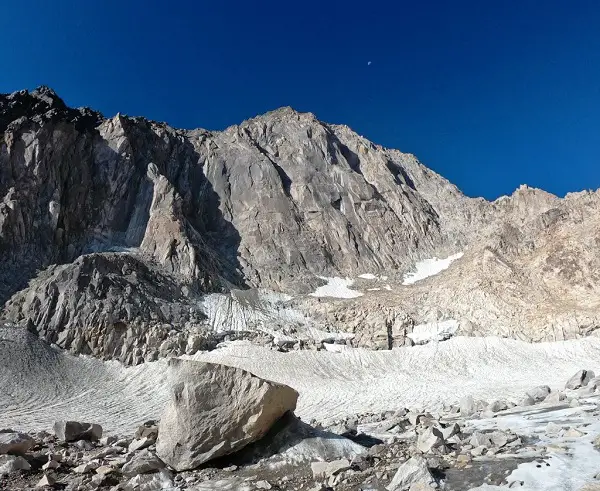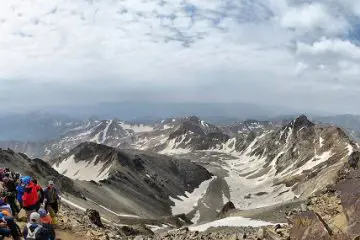Though Alam Kuh is Iran’s second mountain with respect to altitude, it is considered the first among Iran’s big walls. Why? Because of its level of difficulty, its demand of professionality and mastery of techniques, and the challenge of altitude that its routes offer. The summit can be reached through 2 main faces: the southern face which starts from Hesarchal Plain, and the northern face which starts from Alamchal. The southern route is a rather unchallenging one, that’s why most mountaineering groups choose it for their ascent. On the other hand, the northern face includes 3 routes: Siah Sang Route, German Ridge Route, and the Big Wall Route.
Contents

As northern face’s easiest route, Siah Sang Route is still a technical route which requires skill at scrambling and enough caution in the ascent and the descent. The next route to reach Alam Kuh through this face is a rock flank known as the German Ridge (because it was first climbed by a team from Germany). The last route on Alam’s northern face, the one that has won it its world-wide popularity, is one of the most challenging and technical rock-climbing routes in Iran: the big wall route. Follow me on this post to find more about Alam Kuh’s Big Wall.
Alam Kuh’s Big Wall
Takht-e Soleyman Massif (where Alam Kuh is located) has forty-seven +4000 peaks and is known as the Alps of Iran among mountaineers. Alam’s northern big wall which extends from its glaciers to the peak, is a totally vertical 550-meter granite wall that demands technical equipment and rock-climbing skills. Together with the very steep glaciers, the wall has an altitude of 800m. The porous granite wall has different routes with different difficulty levels, routes that have been set by Iranian and non-Iranian teams over the years. What makes climbing the wall so fascinating is the challenge of +4000 altitude that it adds to the difficulty of the ascent and the demand of high professionality. After passing the glaciers, you can start your technical climb at an altitude of 4100 meters.

The Routes on Alam Kuh’s Big Wall
Alam and its northern wall have been attracting mountaineers for a very long time. Beside Iranian mountaineers, professionals from Germany, France, England, Italy and Poland have had ascents of the wall through different routes. The route from the German Ridge, the French Route, is of the first routes set on the flank. The routes on the big wall include:
- Harry Rost/Amir Alaee Route
- Arash Route
- The Kermanshahi Route
- Ehsan Route
- The Italian Route (the Christal Fall)
- The Iranian Route
- The Polish Route 48
- Razhia Route
- The Karaji Route
- The Hamedani Route
- The French Route
- The Polish Route 52
- Shokooh Route
- Bamdad Route
- The Araki Route
- The Tabrizi Route

Alam Kuh’s Big Wall Ascent History
The Original Route
The first route on the wall was set in 1964 by Harry Rost and Fazlollah Amir Alaee. This original route didn’t extend up to the summit. It ended below the part with less strength and durability against weathering and surface disintegration. Two years later, a team of 4 climbers from France Alpine Club spent 25 days to set the big wall’s main route. Known as the French Route, their route included a part of the original Harry Rost Route.
Harry Rost Route
Before the summit, Harry Rost Route includes a very dangerous part with the lowest level of strength and durability (about 150m). Harry Rost didn’t ascend this part, but in 1968 an Iranian team known as Abarmard (Superhuman) under the leadership of Fereydoon Najahkar succeeded in setting a route on this part that extends to the summit.

Polish Route 48
In 1969, a team of 3 Polish mountaineers spent 3 nights on the wall to set Polish Route 48. In most of its pitches, this route requires anchoring. One of its last pitches, the pitch known as Dojourabi, is a common pitch with the 2009 Gorjiha Route. After 20 years from the time it was set, 2 Iranian climbers became the first people to totally ascend this route.
Polish Route 50 and 52
In 1971, Polish Mountaineers set this route in the big gap of the wall. But the main gap is unstable and dangerous, so ascending it requires different techniques. That’s why it is not ascended very much.
In 1973, after 7 days of effort, 5 Polish mountaineers set a straight route on the wall that came to be known as Polish Route 52. It crosses the French Route before it reaches the summit. The 52 Route is a popular route. Climbers ascend most of its pitches to Ghomghomeh Ledge by aid climbing. They don’t continue the route to the end and switch to the French Route or Shokooh Route to reach the top.
Arash Route/ Polish Route 48 / Iranian Route
In 1982, Climbers from different mountaineering groups around Iran set out to set up routes on Alam Kuh’s Big Wall. Arash Mountaineering Team finished setting a new route between Harry Rost Route and the 52 Route in 1984. Another team started climbing the wall through Polish route 48 (which was not yet climbed since it was set). But they took a wrong turn and decided to continue on the wrong path when they found out. The new route they set, the Iranian Route, finished in 1983. Not many climbers have ascended this route.
Shokooh Route
A group of climbers set Shokooh Route from Ghomghomeh Ledge to the summit in 1987. This route, where the famous Abroo Overhanging Face is located, is currently in use.
Hamedani Route
In 1987, mountaineers from Hamedan set 3 pitches on the west side of the 52 Route. After that, in 1989, other climbers continued it up to Ghomghomeh Ledge. Then the last part of the route was set and connected to the previous parts.
The Kermanshahi Route
A team of Italian and Iranian climbers finished setting the Kermanshahi route in 2020. The ascent from this route requires aid climbing and it has a part in common with Harry Rost Route at the end. It is between the Germans Flank and the Iranian Route.
The Karaji Route
Climbers from Karaj started setting a route between the 48 Route and the central gap in 2000 and they finished it in 2009. This route and the 48 Route join in Dojoorabi.
The Italian Route (the Christal Fall)
In 2001, 2 Italian climbers spend 7 days on setting a route on the left side of the gap of Harry Rost Route, next to the Kermanshahi Route. This route, known as the Crystal Fall, has 9 pitches and joins Harry Rost Route after its 8th pitch (where rock is unstable and dangerous).
Araki Route and Tabrizi Route
Araki Route and Tabrizi Route were set in 2007 and 2008 respectively.
The Most Epic Ascents of Alam Kuh’s Big Wall
1981 to 1991 are the time of a revolution in rock climbing in Iran. It was in these years that people like Hosein Talebi Moqaddam and other mountaineers from Hamedan set the record in the history of rock climbing on Alam Kuh’s Big Wall and climbed 3 pitches in a single day. Of the other epic climbs on Alam Kuh’s big Wall was when Hosein Talebi Mogha set the Hamedani Route in 6 hours in 1988, and when Seyyed Hosein Khoshchashm had a free solo ascent of the French Route in 4 hours and 25 minutes in 1990. Also, Hasan Najjarian’s free solo ascent of the Harry Rost Route in 1994 is a wonderful record.
Equipment Required on Alam Kuh’s Big Wall
- The cliff hangers used in Alam Kuh’s Big Wall have a size density of about 0.5 to 2.5. Although anchors cover the routes, you still need to carry a few yourself. You’ll also need a nut tool.
- I recommend having 25 quickdraws (a few of which should be long).
- You must have two 120-centimeter GT 2 belts for the anchor
- Having a work positioning device is a must. Avoid detaching the climb rope from yourself before both of you have reached the summit.
- Don’t remove your helmet even for a moment. When you hear the sound of the rocks falling, don’t look up.
- Polar stretches and a layer of polyester are a good choice. If the weather is nice, you can even climb in a t-shirt.
- Don’t be afraid of bad weather and sleeping on the wall. The best place for bivouac and spending the night on Alam Kuh’s Big Wall is on Ghomghomeh Ledge. The ledge has 2 parts the one on the right is wide.
- It doesn’t matter what kind of belay devices you’re carrying or what kind of path you’ve chosen for your descent. You should have a big figure 8 device for a possible descent from the steep lichen area (between the glaciers and the wall).
- Getting back from Siah Sang is not more difficult than climbing the big wall. But its risky and challenging, maybe because you are tired.

Some Tips for Climbing Alam Kuh’s Big Wall
- Climbing Alam Kuh’s Big Wall is not a joke. The low temperature, high altitude and the fall of rocks require your constant attention and caution. Ascending this big wall requires high physical capabilities, professional skill in rock climbing (free climbing, aid climbing, bivouac, …), heart and lung strength, and muscle strength.
- For ascending Alam Kuh’s Big Wall, you can travel a part of the way on an off-road car. In Bareer, you can get a donkey to carry your stuff and head out for Sarchal. You’d better wait in Sarchal for your stuff to arrive and make your way to Alamchal after that. It takes about 8 hours to get to Alamchal from Bareer.
- You’d better take water with you for the day and night of the ascent and not drink the water of the glacier. You need 1 to 2 liters of water per day. Keep your body’s electrolyte balance from the day before with drinking enough water according to the heat of the season you’ve chosen for your ascent (usually mid-July to early-September).
- Spaghetti, rice, kebab and these kinds of food are better choices than canned food.
- Expect the weather to get as cold as winter any minute and bring your camp and suitable equipment: warm socks, warm gloves, mountaineering jacket and Anorak windbreaker.
- Climbing on one single route with another climber is not impossible, but it will take more time and make things complicated. To avoid it, on the rest day between your arrival to the glacier and your ascent, make arrangements with the other climbers who come to the wall before and after you.
Note:
Rock climbing is not all about the ascent and the descent, it is also about manners and ethics. The priority is with the climber who has come to the glacier before you. Teams with special tasks, like setting routes, repairing routes or ascending difficult routes, have priority over you.











Comments